Related Research Articles

Heretics of Dune is a 1984 science fiction novel by Frank Herbert, the fifth in his Dune series of six novels. It was ranked as the #13 hardcover fiction best seller of 1984 by The New York Times.
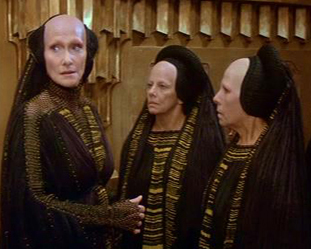
The Bene Gesserit are a key social, religious, and political force in Frank Herbert's fictional Dune universe. The group is described as an exclusive sisterhood whose members train their bodies and minds through years of physical and mental conditioning to obtain superhuman powers and abilities that can seem magical to outsiders. Acolytes who have acquired the breadth of Bene Gesserit abilities are called Reverend Mothers within the organization's ranks. Some of these fictional powers are analyzed and deconstructed from a real-world scientific perspective in the book The Science of Dune (2008).

The Bene Tleilax or Tleilaxu are an extremely xenophobic and isolationist society in Frank Herbert's science fiction Dune universe. Genetic manipulators who traffic in biological products such as artificial eyes, gholas, and "twisted" Mentats, the Tleilaxu are a major power in the Imperium. The race is ruled by a small council of Tleilaxu Masters, whose genetically engineered Face Dancer servants have the ability to mimic any human. The Masters themselves possess a bland and diminutive appearance intended to compel other races to underestimate them. In Heretics of Dune (1984) it is revealed that they are a secret totalitarian theocracy ultimately seeking domination of the known universe. Despite their influence, the Bene Tleilax are universally distrusted and inspire disgust because their products, though desirable, push the moral limits of what humanity at large considers acceptable, and can involve extensive physiological and physical manipulation of human life.
Gaius Helen Mohiam and all the Reverend Mothers within her shuddered. Yes, the Tleilaxu did loathsome things.
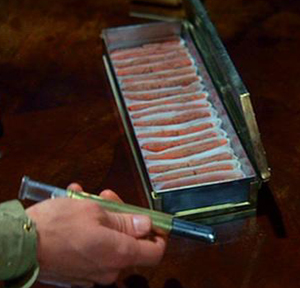
Melange, often referred to as simply "the spice", is the name of the fictional drug central to the Dune series of science fiction novels by Frank Herbert, and derivative works.

The Fremen are a group of people in the fictional Dune universe created by Frank Herbert. First appearing in the 1965 novel Dune, the Fremen inhabit the desert planet Arrakis, which is the sole known source in the universe of the all-important spice melange. Long overlooked by the rest of the Imperium and considered backward savages, in reality they are an extremely hardy people and exist in large numbers. The Fremen had come to the planet thousands of years before the events of the novel as the Zensunni Wanderers, a religious sect in retreat. As humans in extremis, over time they adapted their culture and way of life to survive and thrive in the incredibly harsh conditions of Arrakis. The Fremen are distinguished by their fierce fighting abilities and adeptness at survival in these conditions. With water being such a rare commodity on the planet, their culture revolves around its preservation and conservation. Herbert based Fremen culture, in part, on the desert-dwelling Bedouin, San People, and the Blackfeet Nation.

Arrakis —informally known as Dune and later called Rakis—is a fictional desert planet featured in the Dune series of novels by Frank Herbert. Herbert's first novel in the series, 1965's Dune, is popularly considered one of the greatest science fiction novels of all time, and it is sometimes cited as the best-selling science fiction novel in history.

House Atreides is a fictional noble family from the Dune universe created by Frank Herbert. One of the Great Houses of the feudal interstellar empire known as the Padishah Empire, its members play a role in every novel in the series. It is suggested within the series that the root of the Atreides line is the mythological Greek House of Atreus. In Homer's Iliad, the brothers Agamemnon and Menelaus are dubbed "the Atreides", meaning "the sons of Atreus".

Leto II Atreides is a fictional character from the Dune universe created by Frank Herbert. Born at the end of Dune Messiah (1969), Leto is a central character in Children of Dune (1976) and is the title character of God Emperor of Dune (1981). The character is brought back as a ghola in the Brian Herbert/Kevin J. Anderson sequels which conclude the original series, Hunters of Dune (2006) and Sandworms of Dune (2007). Leto also appears as a child in the prequel The Winds of Dune (2009).

A Guild Navigator is a fictional humanoid in the Dune universe created by Frank Herbert. In this series and its derivative works, starships called heighliners employ a scientific phenomenon known as the Holtzman effect to "fold space" and thereby travel great distances across the universe instantaneously. Humans mutated through the consumption of and exposure to massive amounts of the spice melange, Navigators are able to use a limited form of prescience to safely navigate interstellar space. Control of these Navigators gives the Spacing Guild its monopoly on interstellar travel and banking, making the organization a balance of power against the Padishah Emperor and the assembled noble Houses of the Landsraad.

A sandworm is a fictional creature that appears in the Dune novels written by Frank Herbert.
The Honored Matres are a fictional matriarchal organization in Frank Herbert's science fiction Dune universe. They are described as an aggressive cult obsessed with power, violence, and sexual domination. For this reason they are often described as "whores", especially by their enemies, the Bene Gesserit.

Dune: House Atreides is a 1999 science fiction novel by Brian Herbert and Kevin J. Anderson, set in the fictional Dune universe created by Frank Herbert. It is the first book in the Prelude to Dune prequel trilogy, which takes place before the events of Frank Herbert's celebrated 1965 novel Dune. Bantam Books made a $3 million deal for the novels in 1997. The Prelude to Dune novels draw from notes left behind by Frank Herbert after his death.
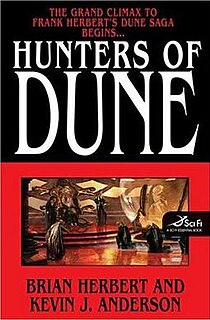
Hunters of Dune is the first of two books written by Brian Herbert and Kevin J. Anderson to conclude Frank Herbert's original Dune series of science fiction novels.

A series of Duneshort stories have been written that relate to the Dune novels by Frank Herbert, Brian Herbert and Kevin J. Anderson. Some of these stories were originally available for download from the official Dune website, released in a promotional capacity in conjunction with the Brian Herbert/Kevin J. Anderson novels. "Dune: A Whisper of Caladan Seas'," "Dune: Hunting Harkonnens," "Dune: Whipping Mek" and "Dune: The Faces of a Martyr" were later published as part of the collection The Road to Dune released in September 2005. "Dune: Sea Child" was published in Elemental, a 2006 benefit anthology for children who survived the 2004 Indian Ocean tsunami, and was later made available as part of the paperback edition of The Road to Dune. "Dune: Treasure in the Sand" was published online in 2006 at Jim Baen's Universe, and was later made available as part of the paperback edition of Hunters of Dune. "Dune: Wedding Silk" was released June 12, 2011 in the Dune e-book short story collection Tales of Dune, which also included previously published stories "Dune: Sea Child" and "Dune: Treasure in the Sand." "Dune: Red Plague" was released on November 1, 2016, followed by "Dune: The Waters of Kanly" in the short story collection Infinite Stars on October 17, 2017.
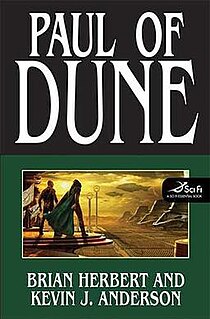
Paul of Dune is a 2008 science fiction novel written by Brian Herbert and Kevin J. Anderson, set in the Dune universe created by Frank Herbert. Released on September 16, 2008, it is the first book in the Heroes of Dune series and chronicles events between Frank Herbert's Dune (1965) and Dune Messiah (1969), as well as between Dune and its 2001 Brian Herbert/Kevin J. Anderson prequel, Dune: House Corrino.
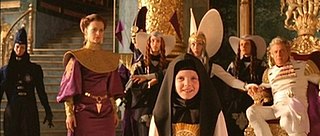
Multiple organizations of the Dune universe dominate the political, religious, and social arena of the fictional setting of Frank Herbert's Dune series of science fiction novels, and derivative works. Set tens of thousands of years in the future, the saga chronicles a civilization which has banned computers but has also developed advanced technology and mental and physical abilities through physical training, eugenics and the use of the drug melange. Specialized groups of individuals have aligned themselves in organizations focusing on specific abilities, technology and goals. Herbert's concepts of human evolution and technology have been analyzed and deconstructed in at least one book, The Science of Dune (2008). His originating 1965 novel Dune is popularly considered one of the greatest science fiction novels of all time, and is frequently cited as the best-selling science fiction novel in history. Dune and its five sequels by Herbert explore the complex and multilayered interactions of politics, religion, ecology and technology, among other themes.
References
- 1 2 Csicsery-Ronay, Jr., Istvan (November 28, 2008). The Seven Beauties of Science Fiction. Wesleyan. ISBN 0819568899.
- ↑ Bahayeldin, Khalid (January 22, 2004). "Arabic and Islamic themes in Frank Herbert's Dune". Baheyeldin.com. Retrieved July 21, 2009.
- 1 2 3 4 5 6 7 8 9 10 11 12 13 14 15 16 17 18 19 20 21 22 23 24 25 26 27 28 29 30 31 32 33 34 35 36 37 38 39 40 41 42 43 44 45 46 47 48 49 50 51 52 53 54 55 56 57 58 59 60 61 62 63 64 65 66 67 68 69 Herbert, Frank (1965). "Terminology of the Imperium". Dune .
- 1 2 3 4 5 6 7 8 9 10 11 12 13 14 15 16 17 18 19 20 21 22 23 24 25 26 27 28 29 30 31 32 33 34 Herbert, Frank (1965). Dune.
- 1 2 3 4 5 6 Herbert, Brian and Anderson, Kevin J. (1999-2001). Prelude to Dune .
- 1 2 3 4 5 6 7 8 9 Herbert, Frank (1981). God Emperor of Dune .
- 1 2 3 4 5 6 7 8 9 10 11 12 13 14 15 16 17 18 19 Herbert, Frank (1984). Heretics of Dune .
- 1 2 3 4 5 6 Herbert, Frank (1969). Dune Messiah .
- ↑ Herbert, Frank (1965). Dune, Terminology of the Imperium (Jihad, Butlerian).
- 1 2 Collins, Will (September 16, 2017). "The Secret History of Dune". Los Angeles Review of Books . Retrieved October 20, 2017.
- 1 2 3 4 Herbert, Brian and Anderson, Kevin J. (2002-2004). Legends of Dune .
- ↑ "Audio excerpts from a reading of Dune by Frank Herbert". Usul.net. Retrieved October 6, 2010.
- ↑ Herbert, Frank (1965). "Afterword: by Brian Herbert (2005)". Dune, 40th Anniversary Edition (Dune Chronicles: Book 1). Ace Books, NY. pp. 523–525. ISBN 0-441-01359-7.
- ↑ Herbert, Frank (1965). Dune, Terminology of the Imperium (Ecaz).
- 1 2 3 4 Herbert, Frank (1985). Chapterhouse: Dune .
- 1 2 3 4 5 Herbert, Brian and Anderson, Kevin J. (2006) Hunters of Dune .
- 1 2 3 4 Herbert, Frank (1976). Children of Dune .
- ↑ Herbert, Frank (1965). Dune, Terminology of the Imperium (Snooper, Poison).
- 1 2 Herbert, Frank (1965). "Appendix IV: The Almanak en-Ashraf (Selected Excerpts of the Noble Houses): VLADIMIR HARKONNEN". Dune .
- ↑ Herbert, Frank (1987-07-01). Chapterhouse: Dune . Princeton, N.J.: Ace. pp. 84. ISBN 9780441102679.